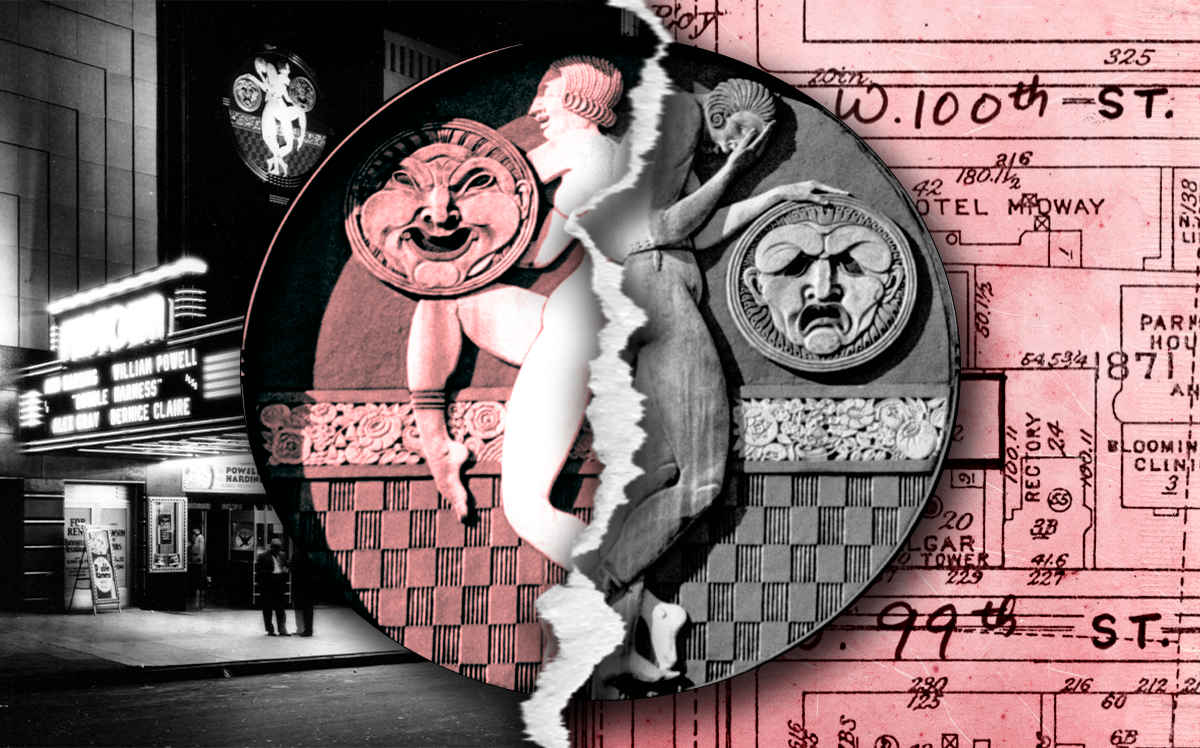 Big month for retail sales bodes well for landlords
Big month for retail sales bodes well for landlords
Trending
Vacant for 15 years, landmarked UWS theater holds out hope
The Metro Theater says it’s close to landing a tenant after a string of deserted deals. Will it finally succeed?

Even on a block where the majority of its neighboring buildings are landmarked, the Metro Theater stands out. For one thing, it’s tiny: at just two stories, the Metro is an Art Deco splinter in the foot of the Ariel East, Extell’s 37-story glass tower that’s so tall it made Upper West Siders shriek with dismay when its design was revealed.
The theater’s tri-colored, terra cotta façade, which used to advertise showings of adult cinema classics like “The Organ Trail,” is “one of the finest façades of its type,” according to city historians.
But beneath the beauty, the bottom line is something scarier. Despite occupying 10,000 square feet of prime real estate in one of Manhattan’s wealthiest neighborhoods, the Metro is empty. In fact, the little theater at 2626 Broadway between 99th and 100th Streets hasn’t had a tenant since 2006.
Its owner, Albert Bialek, has teased one new lease after another, with uses ranging from an arthouse cinema chain to a budget gym. But each proposal has fallen flat, and in the meantime, Bialek has been charged more than $840,000 in city property taxes, according to public records.
Landmarked buildings don’t need to be financial losers. The city landmarks everything from the Empire State Building to townhouses in Park Slope. More than 37,000 properties are subject to the preservation department’s restrictions on development and renovations. But the Metro has failed to thrive for a unique set of reasons as varied as its history.
The movie palace
“The Upper West Side was always deemed the creative side,” said Sean Khorsandi, the executive director of Landmark West!, a nonprofit that strives to preserve historic properties in the neighborhood. “The [Upper] East side was money money money, the high society,” he said. Meanwhile, the West could get down.
As films grew more sophisticated, adding sound and then color, so too did the buildings where people watched them. In the 1920s, opulent movie palaces spread across the country, becoming cultural and community centers. Guests could socialize in their double-height foyers before taking in weekly newsreels in lush theaters so large they could seat thousands.
The Metro was no such palace. “What’s interesting about the Metro is it was not meant to be a huge nexus for the arts,” Khorsandi said. “This was a neighborhood theater.”
As the Great Depression bore down on everyday New Yorkers, movie palaces gave way to smaller cinemas. They only sat a few hundred people, but offered an attainable way for people to dip their toes in comfort for a couple hours a week.
Architectural firm Boak & Paris designed the Metro (then called the Midtown) in 1932. The theater opened shortly after Radio City Music Hall, at the height of New York’s Art Deco phase.
In preservation and redevelopment fights, people often battle over what comes next. But what came before the Metro is critical, too: In November 1931, as the national unemployment rate jumped to nearly 16 percent, developers knocked down a seven-story tenement to make way for the theater. It offered cultural enrichment, but came at the expense of low-cost housing.
“If one were to have strolled this section of Broadway,” observed Lynne Marthey, the city researcher who studied whether to landmark the theater in 1989, “one would have had a choice of eighteen theaters in which to see movies.” By the late ‘80s, only four of those cinemas still stood; now the Metro is alone.
Starts and stops
No one is able to say with certainty why the Metro closed. Some cite the construction noise of the Ariel East and West, which no doubt made it difficult to watch a movie in peace. Others point to a late operator’s preference for limited-release foreign films; even on the Upper West Side, there are only so many Fellini buffs.
The Metro sits in a potentially lucrative corner of Manhattan — it’s within easy walking distance for both the wealthy denizens of Central Park West and the students and faculty of Columbia University.
“The market, specifically up here, has shifted a lot,” said Michael Shkreli, a retail broker for Winick focused on the neighborhood. “You have a lot more A-credit-type tenants, the Sweetgreens of the world, signing leases,” he said.
Broadway in particular opens up different opportunities for tenants. The double-wide thoroughfare is a valley of big-box retail between Amsterdam Avenue’s small restaurants and the dense residential developments further west.
The Metro has sat empty, but not for lack of trying. In 2009, it had its first brush with post-theater tenancy. Then-Winick president Benjamin Fox announced that Urban Outfitters had signed a 20-year lease in the building. But even then, there were signs something may be off.
“It’s not the easiest space to work with,” Urban Outfitters’ then-CEO Ted Marlowe told Women’s Wear Daily. “We still have some work to do,” he said.
Ultimately, the trendy clothing retailer backed out and set up a storefront directly across Broadway. Shoppers could see the theater’s landmarked facade as they exited the new location.
Although Urban never moved in, the abandoned deal still left its mark on the Metro. The old dual-screen theater was gutted to make way for an anticipated retail store, leaving a historic exterior but a blank slate inside. Now, it’s neither theater nor store, a master-of-none in an area full of other opportunities.
“People who want a theater don’t want to build one from scratch, and people who want retail space, there’s a glut of retail space now,” said Khorsandi.
Read more
 Big month for retail sales bodes well for landlords
Big month for retail sales bodes well for landlords
 UWS Metro Theater to become retail complex
UWS Metro Theater to become retail complex
The Metro’s next heartbreak came in 2013. Alamo Drafthouse, the Austin-based cinema chain that serves up dinner, beer and artsy films, was in the midst of renovations to convert the space into a five-screen theater. The company’s CEO did a lengthy interview with West Side Rag, and photos of the construction appeared in the New York Times. They even released a menu for the location.
Then came the blog post.
“Ultimately the location is no longer financially viable for us,” the company wrote in October 2013, citing rising construction costs resulting from Hurricane Sandy recovery efforts. “We would love to make the Upper West Side location our next neighborhood theater in New York, but we cannot see this particular location as sustainable under current conditions.”
One source close to the negotiations says a national theater chain with celebrity ownership is set to move in next. But for now, the theater’s chipped red paint reflects the late-summer sunshine just as it has for over a decade as it settles in for yet another lonely winter.
“Every time I’ve walked by that building, I’ve had a note of sadness, like ‘Ah, what they could do with this,’” said Steven Brown, chair of Manhattan Community Board 7. But even more recent efforts to convert the building into a Blink Fitness couldn’t succeed.
In July of last year, the DOB denied a proposal to convert the theater into a general retail space, public records show. The project would’ve cost an estimated $1.2 million and added nearly 10,000 square feet of space. Bialek remains unfazed, and in a series of phone interviews maintained that something is just around the corner.
“Just a day or two away from signing the lease with a very special tenant,” he said last Friday. “The tenant we’ve been waiting for.” But as of yet, the papers aren’t official. While it awaits its next star turn, Broadway moves on without it.
“This is just a blip on the radar in the life of this landmark,” said Khorsandi.




